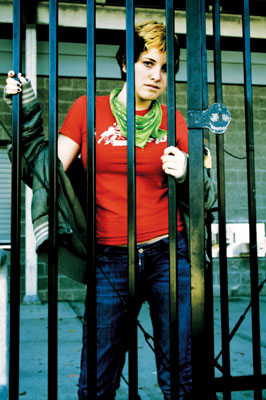All Nonfiction
- Bullying
- Books
- Academic
- Author Interviews
- Celebrity interviews
- College Articles
- College Essays
- Educator of the Year
- Heroes
- Interviews
- Memoir
- Personal Experience
- Sports
- Travel & Culture
All Opinions
- Bullying
- Current Events / Politics
- Discrimination
- Drugs / Alcohol / Smoking
- Entertainment / Celebrities
- Environment
- Love / Relationships
- Movies / Music / TV
- Pop Culture / Trends
- School / College
- Social Issues / Civics
- Spirituality / Religion
- Sports / Hobbies
All Hot Topics
- Bullying
- Community Service
- Environment
- Health
- Letters to the Editor
- Pride & Prejudice
- What Matters
- Back
Summer Guide
- Program Links
- Program Reviews
- Back
College Guide
- College Links
- College Reviews
- College Essays
- College Articles
- Back
The Need for Better Education in Juvenile Detention Centers
Receiving a quality education is important to the development and future of any child. However, a quality education is especially important to youth involved with the juvenile justice system as education helps these youth to surmount environmental challenges, reform their relationship with education, and ultimately prevents recidivism, the act of previously offending criminals committing crimes. Despite this, the United States’ juvenile detention centers consistently provide subpar education. As citizens, we can no longer nonchalantly accept the preset outcomes to involvement with the juvenile justice system. Reforms to the education systems of juvenile detention centers are necessary to increase offending juveniles’ likelihood of future success.
As reported by the Southern Education Foundation, more than 50% of incarcerated juveniles are significantly below grade level in learning. Furthermore, according to the U.S. Department of Education, the vast majority of “long-term” students, those incarcerated for 90 days or more, made no improvements in learning and/or academic achievement. Additionally, although up to 70% of incarcerated juveniles require special education, over 25% of these students received no special education. In today’s society, the education America’s juvenile prisons provide only exacerbates how disadvantaged justice-system-involved youth are, as poor quality education is proven to hinder success. With only 9% of incarcerated juveniles attaining a high school diploma or GED, 91%’s median family income will be a mere 30% of that of a college graduate’s median family income. Needless to say, without delivering high-quality education, the United States’ juvenile detention centers are unfortunately, yet essentially preparing incarcerated youth to fail.
The deficient education most juvenile prisons provide stems from a multitude of sources, but according to the Washington Post, the source most prominent is the lack of accountability for the education provided within juvenile prisons. Some may argue under the No Child Left Behind Act a lack of accountability for education quality is impossible as the act requires every school’s achievement to be measured by standardized testing and for struggling schools to take appropriate steps to improve. However, according to a study conducted by the Council State Governments Justice Center juvenile detention centers weren’t keen in taking notice of the act. Often times, the problem is data isn’t even being collected as 40% of incarcerated youth are housed in privately run facilities whose performances on testing aren’t collected by the state. Furthermore, the study concluded that in 80% of states no one person or agency is responsible for the education of incarcerated youth, prompting a lack of leadership, adding fuel to the fire of lack of accountability. Naturally, without sufficient data measuring achievement of incarcerated students and without leadership, it’s impossible to identify and work to improve the education quality prevalent within our nation’s juvenile detention centers.
Because of the demonstrated power education possesses to reduce recidivism in juveniles, it’s imperative for juvenile detention centers to be enabled to provide high quality education. The most effective way juvenile detention centers can be enabled to do this is through increased federal funding. An increase in federal funding would provide needed resources, including books, classrooms, and well qualified teachers. Additionally, funding could be devoted to addressing the needs of the disproportionate amount of incarcerated children who require special education. Although states may be reluctant to provide more funding, the lower recidivism and subsequent lower cost of incarceration would compensate.
Although many readers have the privilege of being exempt from the juvenile justice system, as Americans, it is still our responsibility to uphold the founding philosophy of our country: opportunity for all. With this, being a good citizen is more than simply voting, it is spreading the word and raising awareness about the poor education prevalent within our juvenile detention centers in hopes of inflicting change and restoring opportunity to incarcerated youth.
Bibliography
Brown, Emma. “Educational Opportunities Lag for Kids in Juvenile Detention, Study Finds.” The Washington Post, WP Company, 5 Nov. 2015.
“Just Learning: The Imperative to Transform the Juvenile Justice System.” SEF - Southern Education Foundation,
www.southerneducation.org/Our-Strategies/Research-and-Publications/Just-Learning.aspx.
“Locked Out:Improving Educational and Vocational Outcomes for Incarcerated Youth.” Nov. 2015.
Theilbar , Kimberly. “Education in Juvenile Detention Centers.

Similar Articles
JOIN THE DISCUSSION
This article has 0 comments.

Through this piece, I hope to raise awareness and start conversations about the education incarcerated juveniles receive.